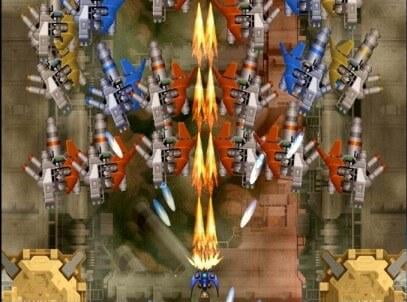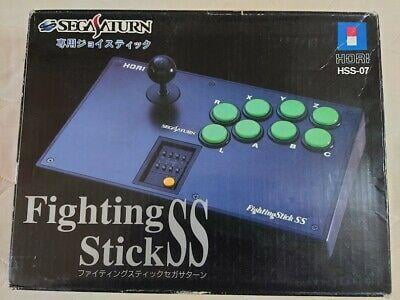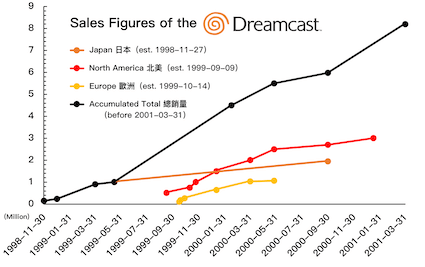Console Wars: The Sega Saturn and the Sega Dreamcast were two machines that enjoyed as many similarities as they did stark differences. One system marked the end of the 90s gaming era, and the other ushered in the much-heralded 6th-generation of consoles that defined the new millennium.
And while both were manufactured by Sega, both were also responsible for hastening that company’s demise. But despite being regarded as failures at the time, their reputations have only improved in the intervening years. A Reddit thread on the subject of the Sega Dreamcast was a veritable love-in, and some Sega Saturn games, like “Panzer Dragoon Saga,” are so in-demand that they fetch hundreds of dollars on the retro game market.
This all begs the question, which is the better machine? Like anything, much of it depends on personal preference. But here’s how the two systems stack up according to certain criteria important to gamers young and old.
The Games: Dreamcast vs Sega Saturn
Both consoles score highly among fans when ranked solely by their respective games’ library. Each had their own strengths: the Saturn had some iconic and fun arcade ports like “Virtua Fighter 2”, “King of Fighters”, “Sega Rally”, and “Street Fighter,” to name a few.
While the Sega Dreamcast had its own excellent titles like “Power Stone”, “Shenmue”, “Jet Set Radio” and “Soul Calibur” as well as wildly popular exclusive titles like “Crazy Taxi.” How can I forget playing Marvel vs Capcom 2 on the dreamcast, which is a great fighting game and probably the best arcade port of the game.
The Shmups / Shooters:
 While
both consoles featured rail shooters, like The House of the Dead, which
first came out on the Sega Saturn and The House of the Dead 2 on the
Sega DreamCast. Both consoles featured some real good shmups, the
Saturn had a few that really stick out like Radiant Silvergun, Battle
Garegga, Dodonpachi, and the list goes on. Sure, the DreamCast had some
cool shmups that come to mind: Bangai-O, GunBird 2 the GigaWing
Series.
While
both consoles featured rail shooters, like The House of the Dead, which
first came out on the Sega Saturn and The House of the Dead 2 on the
Sega DreamCast. Both consoles featured some real good shmups, the
Saturn had a few that really stick out like Radiant Silvergun, Battle
Garegga, Dodonpachi, and the list goes on. Sure, the DreamCast had some
cool shmups that come to mind: Bangai-O, GunBird 2 the GigaWing
Series.
The Sonic the Hedgehog Series:
When one thinks of sega, generally the first title that comes to mind is Sonic the Hedgehog. Both consoles had their fair share of Sonic Titles, as you’d imagine, but the saturn didn’t really bring any huge improvement to the series. Sonic 3D Blast & Sonic R are similar to games from the sega genesis and the sega game gear libraries. The dreamcast however had two new additions into the series with Sonic Adventure & Sonic Adventure II. The sonic team also created a Mario party clone in sonic shuffle. Which is a very similar board game style game.
The RPGs:
That said, the Saturn’s library of games has earned an almost mythic status in the retro market due to its abundance of RPGs like Dragon Force, Shining Force III, Albert Odyssey, Guardian Heroes, Panzer Dragoon Saga and one of my favorite games Magic Knight Rayearth. The first Skies of Arcadia was a great RPG on the dreamcast, The Shenmue series is fantastic, Grandia II, and Elemental Gimmick Gear come to mind.
Sports Games:
I do want to mention sports games, because the dreamcast really had some decent games. 2K really created some solid basketball games. I know sports games are a dime a dozen, but when you do them right, you should be recognized.
So while many Saturn titles have become nostalgic favorites among hardcore gamers, the Dreamcast games continue to offer playable fun to this day. However, the total number of games for the Sega Dreamcast stands at just over 600 compared to over 1100 for the Sega Saturn. When I look at both libraries, to me the dreamcast is the more complete library. The dreamcast has a bit of everything in its library: from some great Arcade Games, Flight Games, 2D Fighting Games, and so on. While both consoles featured some excellent 3d fighters, but I have to go with the dreamcast on this one!
Winner: DreamCast
The hardware: Dreamcast vs Sega Saturn
No surprise here that the Dreamcast offered more powerful overall specs than its predecessor. While the two systems claimed both 3D platform games and nice 2D platformers. However, It was the Dreamcast’s 128-bit processor that left the Saturn’s 32-bit capabilities in the dust. Add to that the fact the Dreamcast was designed with 3D gaming in mind, and you had a console that delivered very well on this front. Still, anyone who has played a few of the Saturn’s 2D gaming titles, like “Street Fighter Alpha” and “X:Men,” can make a strong argument that this machine’s 2D library was superior. What tips the balance one way or the other is the fact that the Dreamcast utilized Hitachi’s SH4 processor, a PC-powerful chip that hummed along at 200 MHz. The Saturn’s dual VDP chips, on the other hand, simply couldn’t compete.
Winner: Dreamcast
The sound
Right from the get-go, the Sega Saturn was praised for its Yamaha YMF292 dedicated sound card. This custom processor featured a 32-slot sound generator and a 128-step digital signal processor that allowed it, among other things, to create sound mixes and generate digital sound effects. The Dreamcast, by virtue of the fact it was the first of the sixth-gen consoles, had solid sound too, but it didn’t stand out the way the Saturn’s did. The winner here is obvious.
Edge: Saturn
The controller
The controllers for both the Dreamcast and the Saturn play to those consoles’ strengths. Those who reveled in mashing circular buttons in the arcade found much to
love in the Saturn’s understated 6-button controller. It was perfect for
2D gaming. If the Saturn analogue controller wasn’t your cup of tee,
Hori made some awesome arcade sticks that really are great for that
arcade experience. You can still find these today on sites like eBay.
who reveled in mashing circular buttons in the arcade found much to
love in the Saturn’s understated 6-button controller. It was perfect for
2D gaming. If the Saturn analogue controller wasn’t your cup of tee,
Hori made some awesome arcade sticks that really are great for that
arcade experience. You can still find these today on sites like eBay.
Both consoles had different controller peripherals for each console. Like flight sticks, driving wheels, and light gun blasters. The light gun on the Saturn was big and bulky, I was always a fan of the more compact light gun for the dreamcast. Sega did make a unique 3d controller just for Nights into Dreams, which had pretty great 3D graphics on the Sega Saturn.
Dreamcast fans, on the other hand, had a modern controller that played to the system’s 3D prowess by offering an analogue controller as well as the standard buttons. The addition of memory card slots allowed Dreamcast gamers to save their progress more efficiently than the Saturn’s internal memory did, or messing with a ram cartridge. For this reason, the Dreamcast has to come out ahead.
Edge: Dreamcast
The console sales Saturn Vs DreamCast

High sales don’t always translate to quality. However, there are some passionate forum debates out there weighing the merits of these two systems based on their respective sales figures. Online numbers tend to vary, but official estimates tend to place lifetime sales of the Saturn in the 9.26 million range, while the Dreamcast sold around 9.13 million. But there are ancillary factors to consider as well, such as the fact that the Saturn had a slightly longer shelf life (released in North America in 1995 and discontinued in 1998) than the Dreamcast did (released in 1999 in North America and discontinued in 2001.)
Those who judge these consoles solely based on sales can come to one of two conclusions: that the Dreamcast did better because it virtually tied the Saturn in sales in a slightly shorter timeframe; or the Saturn wins because it (barely) edged out the Dreamcast in overall sales. Since the opportunities to nitpick here are almost endless, we absolve ourselves of any further headaches by simply calling it a push.
Edge: tie
Even while trying to remain impartial, it’s hard to make a fully subjective choice between these two consoles. Much of the choice does come down to personal preference (for games, hardware, controller, etc.), so a truly official winner may never be crowned. This reality seems to have been borne out by the above list, which takes into account a number of criteria yet makes it clear the sleek and powerful Sega Dreamcast matches up equally with the sturdy and game-rich Sega Saturn.
No comments :
Post a Comment